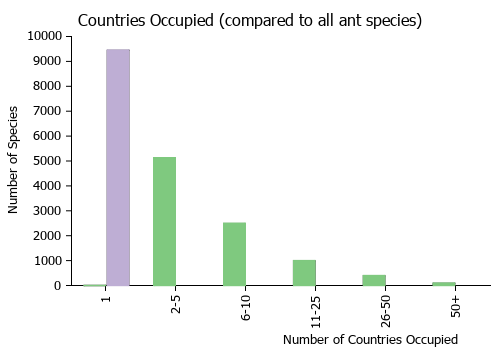Ocymyrmex cursor
| Ocymyrmex cursor | |
|---|---|

| |
| Scientific classification | |
| Kingdom: | Animalia |
| Phylum: | Arthropoda |
| Class: | Insecta |
| Order: | Hymenoptera |
| Family: | Formicidae |
| Subfamily: | Myrmicinae |
| Tribe: | Crematogastrini |
| Genus: | Ocymyrmex |
| Species: | O. cursor |
| Binomial name | |
| Ocymyrmex cursor Bolton, 1981 | |
Nothing is known about the biology of Ocymyrmex cursor.
Identification
A member of the laticeps group
Bolton (1981) - The closest relative of cursor is Ocymyrmex laticeps, also from Angola.
laticeps - Smaller species, HW 1.70-1.74, SL 1.56, PW 1.08-1.14. Head slightly broader than long, CI 102-103. Metapleural lobes vestigial, scarcely or not visible in absolute profile. Anterior half of propodeal dorsum sloping downwards, posterior half more or less level. Petiole node in profile with a short, narrowly rounded dorsum. Postpetiole longer than broad in dorsal view.
cursor - Larger species, HW 2.04, SL 1.94, PW 1.30. Head slightly longer than broad, CI 98. Metapleural lobes large, conspicuous in absolute profile. Anterior half of propodeal dorsum shallowly concave, posterior half rising and shallowly convex. Petiole node in profile with an elongate, almost flat dorsum. Postpetiole broader than long in dorsal view.
Sculpture in the two species is very similar and they also share the characters of lacking a semicircular clypeal impression and possessing a broad ventral process on the peduncle of the petiole. Five other known species do not have a semicircular impression in the middle of the anterior clypeal margin, Ocymyrmex cavatodorsatus, Ocymyrmex velox, Ocymyrmex ankhu, Ocymyrmex zekhem and Ocymyrmex turneri, but none of these has the strongly developed constriction of the first gastral tergite seen in laticeps and cursor, and all lack a subpetiolar process. Apart from this turner; is small (HW < 1.30) and has large eyes which break the outline of the sides in full-face view; velox has a high, strongly convex petiole node and very feeble cephalic sculpture; and cavatodorsatus has the alitrunk strongly saddle-shaped in profile and the posterior half of the cephalic dorsum unsculptured.
Keys including this Species
Distribution
Distribution based on Regional Taxon Lists
Afrotropical Region: Angola (type locality).
Distribution based on AntMaps
Distribution based on AntWeb specimens
Check data from AntWeb
Countries Occupied
| Number of countries occupied by this species based on AntWiki Regional Taxon Lists. In general, fewer countries occupied indicates a narrower range, while more countries indicates a more widespread species. |

|
Estimated Abundance
| Relative abundance based on number of AntMaps records per species (this species within the purple bar). Fewer records (to the left) indicates a less abundant/encountered species while more records (to the right) indicates more abundant/encountered species. |

|
Biology
|
Castes
Known only from the worker caste.
Nomenclature
The following information is derived from Barry Bolton's Online Catalogue of the Ants of the World.
- cursor. Ocymyrmex cursor Bolton, 1981b: 267 (w.) ANGOLA.
Unless otherwise noted the text for the remainder of this section is reported from the publication that includes the original description.
Description
Worker
Holotype. TL 9.7, HL 2.08, HW 2.04, CI 98, SL 1.94, SI 95, PW 1.30, AL 2.74.
Anterior clypeal margin with a minute and very shallow inconspicuous indentation in the apron medially, without a conspicuous semicircular impression flanked by a pair of teeth. With the head in full-face view the occipital margin very shallowly but quite broadly concave. Maximum diameter of eye 0.44, about 0.22 x HW. Promesonotum in profile evenly rounded, sloping posteriorly. Anterior half of propodeal dorsum very feebly concave but above the spiracle very shallowly convex before rounding broadly and evenly into the declivity. Metapleural lobes prominent and narrowly rounded, easily visible in profile, not concealed by the bulge of the metapleural glands. Peduncle of petiole with a broadly triangular low blunt process on its ventral surface, about half-way between the insertion and the level of the spiracle. Node of petiole in profile low and broadly rounded, with a differentiated dorsal surface which is almost flat. In dorsal view the petiole node as long as broad, the postpetiole broader than long. Base of first gastral tergite constricted, forming a neck in dorsal view. Dorsum of head costulate, predominantly longitudinally so but with a few arching in over the eye. Ground-sculpture a fine superficial granulation or punctulation which is more conspicuous away from the midline of the head. Centre of pronotal dorsum almost smooth, with only vestigial sculpture; in front of this arched-transverse costulae are present and behind it longitudinal costulae run back between the mesothoracic spiracles. Remainder of dorsal alitrunk and propodeal declivity transversely rugose. Sides of alitrunk densely and evenly costulate-rugose, the sculpture regular except around the propodeal spiracle. Petiole ventrally transversely rugose from the level of the process and the peduncle dorsally with a few weak transverse rugae. The node itself more weakly sculptured, mostly with superficial patterning only but the posterior face with a few weak transverse rugulae. Postpetiole only with superficial patterning. Dorsal surfaces of head and alitrunk with numerous hairs of varying length but first gastral tergite only with scattered short hairs. Alitrunk glossy dull red, the head lighter and with an orange tint, the gaster darker, reddish brown.
Type Material
Holotype worker, Angola: Kopeio, vii.1931 (T. D. A. Cockerell) (The Natural History Museum).
References
- Bolton, B. 1981. A revision of six minor genera of Myrmicinae (Hymenoptera: Formicidae) in the Ethiopian zoogeographical region. Bulletin of the British Museum (Natural History) Entomology. 43:245-307. (page 267, worker described)
References based on Global Ant Biodiversity Informatics
- Bolton B. 1981. A revision of six minor genera of Myrmicinae (Hymenoptera: Formicidae) in the Ethiopian zoogeographical region. Bulletin of the British Museum (Natural History). Entomology 43: 245-307.
- Bolton B., and A. C. Marsh. 1989. The Afrotropical thermophilic ant genus Ocymyrmex (Hymenoptera: Formicidae). Journal of Natural History 23: 1267-1308.

